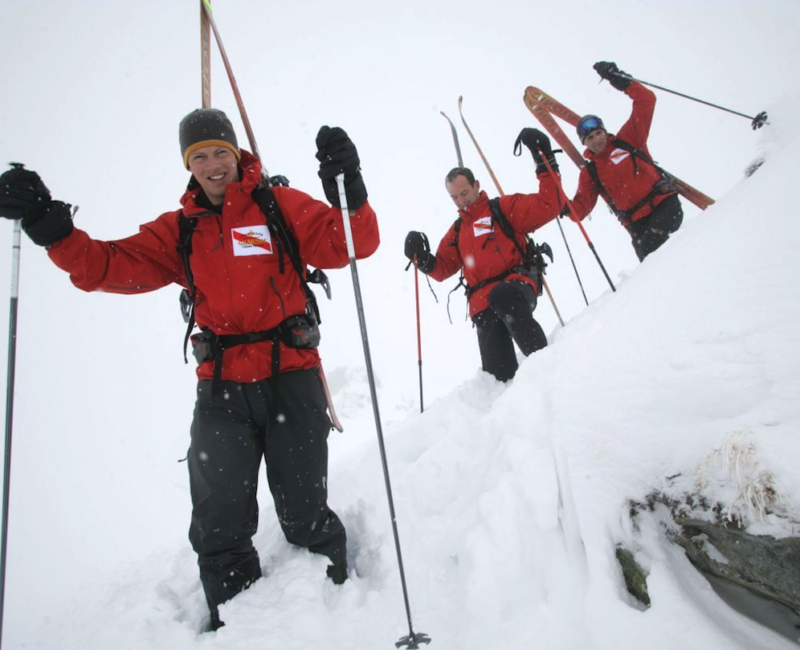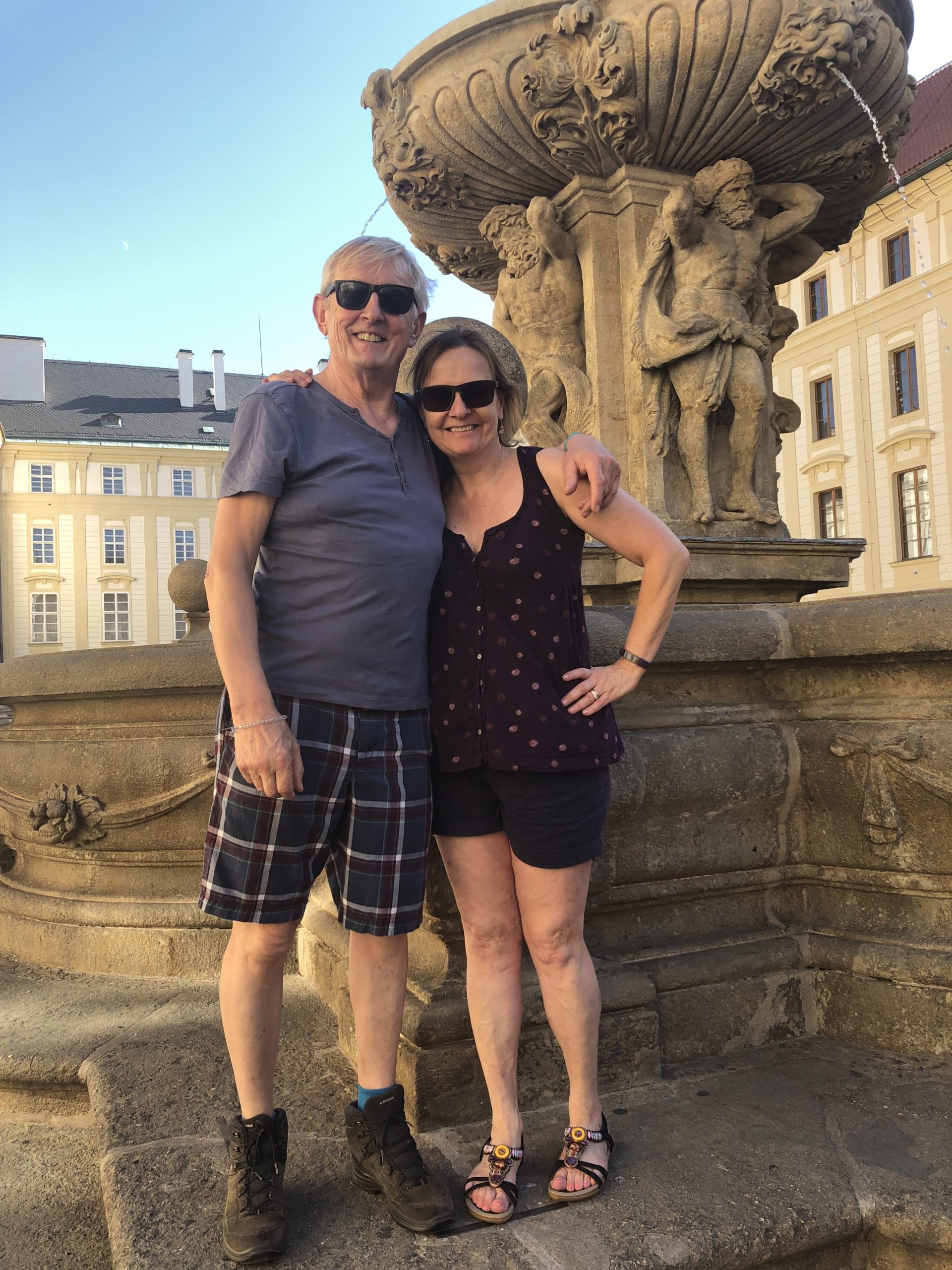
Patrouille des Glaciers: Ascent to Riedmatten at dawn
Tom And there were several times when we got it wrong and dogs, sleds, people ended up in the water. And the water temperature of the Arctic Ocean is a steady minus 1.8 degrees Celsius, which is the temperature that sea water freezes air temperature –40. And you get out of that water and it’s a battle for survival.
Peter Welcome to our travel podcast. We’re specialist travel writers and we’ve spent half a lifetime exploring every corner of the world.
Felice So we want to share with you some of our extraordinary experiences and the amazing people we’ve met along the way.
Peter Tom Avery, pioneering Polar adventurer and ski mountaineer, you’re one of just nine people in history to have completed the Polar Trilogy that’s reaching both the South and North Poles, along with a coast-to-coast crossing of Greenland. You hold two Guinness World Records and you’re the youngest Brit ever to reach both Poles. However, did this all come about?
Tom Well, I just love snow. Ever since I was a young boy, I’ve just been absolutely infatuated by snow: this extraordinary thing that falls out of the sky can transform a landscape into something utterly stunning and spectacular and provides a vast array of really fun ways to get around. Be that getting up a mountain, skiing down the other side, driving dog teams through the snow, using ice axes and crampons to climb up a snowy peak. That obsession has been with me ever since I can remember and I hope it never leaves.
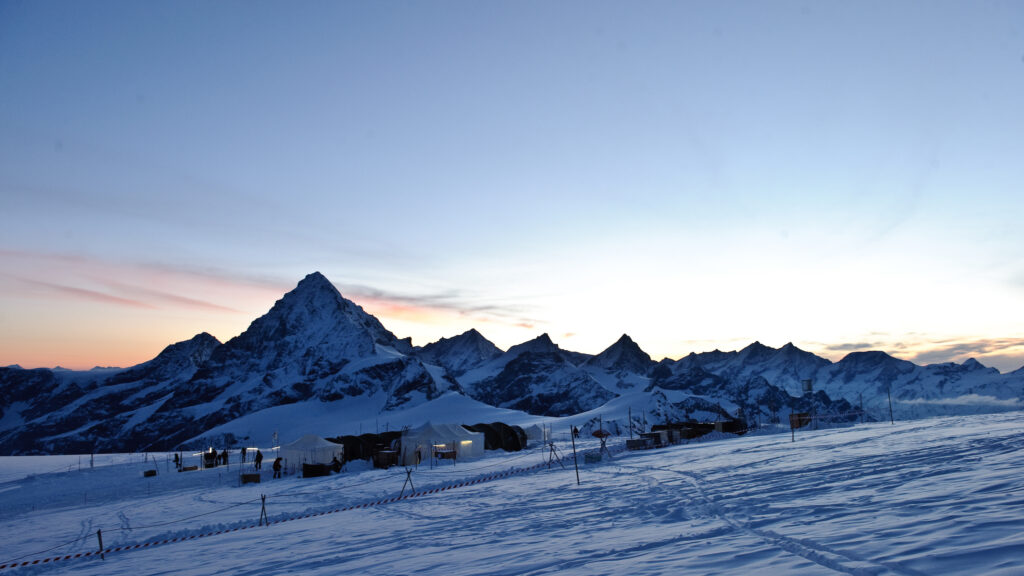
Patrouille des Glacier – Zermatt’s Tete Blanche
Felice So what age did your outdoor career begin?
Tom I was probably I think about seven or eight years old when I first read about the adventures of Captain Scott. So my father used to give me these Ladybird story books to read about Marco Polo, Joan of Arc… and the one about Captain Scott I just couldn’t put it down. And I read it again and again and again. It was just an extraordinary tale of adventure in this otherworldly snowy landscape that was dangerous and challenging, yet utterly beautiful and untouched. And although I didn’t really understand why at the time, I knew that my life wouldn’t be complete until I had got down there to Antarctica myself and seen this extraordinary place first hand and challenged myself to clip into the skis and a sled harness and see how I would fare.
Felice So when was your first expedition?
Tom My first expedition was probably about 10 or 11 years of age, which was camping in the South Downs with school, and we were toasting marshmallows over the fire and just those first few nights under canvas and just being in the great outdoors, it was amazing. And it just shows you don’t need to go off to the highest mountains or the polar ice caps to have an adventure. I still get as much of a thrill going camping with the kids at home in the Cotswolds now as I did back then as a young boy. And I guess over the years, the adventures then got more ambitious and took me further afield. That real sense of adventure and the great outdoors, it’s all the same wherever you are.
Peter So the first actual expedition was to where?
Tom So, in terms of expeditions, the first big one was a trekking expedition to the Indian Himalayas on my year off after school. It was an amazing experience, hard, it was about a month-long trek through the Zanskar Mountains. And I guess we went up to about 18,000 feet; we crossed glaciers, mountain passes.

I’d done quite a lot of climbing at school and trips up to the Lake District, Snowdonia and Ben Nevis, using ice axes and crampons for the first time. But this was my first real adventure. And to be surrounded by these enormous mountains was an incredible experience, and also the amazing mountain people who make the Himalayas their home. And I’ll never forget those seeing those prayer flags on the top of this mountain pass. It took four or five days to reach the top and there was often a little shrine with these prayer flags everywhere. And just that human connection with the mountain was something I’ll never forget.
Felice And which mountains have you climbed? Any famous ones we’d know?
Tom In terms of the mountains I’ve climbed, Mount Everest has never really had that much appeal to me. Yes, it’s the most famous, highest mountain out there, but it’s never really appealed that much. I mean, I’ve got huge admiration for anyone who’s climbed it, but I’m someone who just likes to get away from it all. A lot of the expeditions that I went on subsequently after India, they would be to quite remote mountain ranges where there were very few, if any, other climbers. So that could be in places like Bolivia or Chile, or climbing in Morocco.
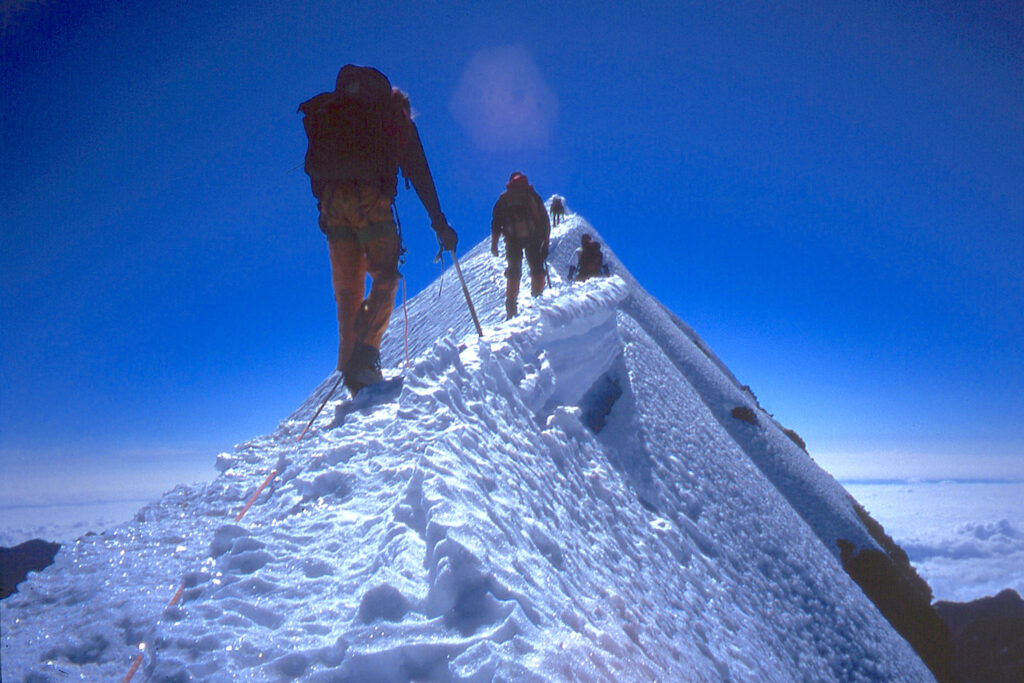
Summit ridge of Condoriri, Bolivia
But probably the highlight of my climbs was to a country called Kyrgyzstan deep in Central Asia, which had been off limits to western climbers for decades. And then when the Stans started gaining their independence, they provided an opportunity to go in and effectively climb in a region that had never been really explored, apart from a few yak herders.
And we did a lot of research beforehand in places like the Royal Geographical Society in the Map Room there, in the Alpine Club, just to try and find whatever information we could about this place. And it was like harking back to those days of Scott and Shackleton – those were early Victorian pioneers climbing these mountains for the first time that no one had climbed, visited, even named. And it took a lot longer to get to the top of one of these mountains than it would a regularly climbed peak.
But it has no guidebooks to show you either way up. And a lot of the time you have to turn back because the ridge that you’re following is the wrong way. But it means that when you do reach the top of one of these peaks, these unclimbed mountains, it does just feel very special knowing that you’re the first people to to reach the top and to see the views. And it was very special.
And you obviously get the privilege of naming the peaks yourself. So we came up with all sorts of names on the expeditions. In fact, we named one of the peaks after Sir Ranulph Fiennes, who was the patron of our expedition. I actually climbed one of the peaks on my mother’s birthday and I’d actually totally forgotten to get her a birthday present that year. She got a mountain named after her instead.
Peter So tell us about your first polar expeditions?
Tom The South Pole had been bugging me for a long time, and after Kyrgyzstan, I kind of felt as though I’d served my expedition apprenticeship and learnt to survive for many weeks on end in the snow, in extreme conditions. And yes, it was time to go for for the big one. My career at this stage is sort of slightly chequered in that I’d trained to be an accountant in the City of London, and it didn’t really last for very long. My mind was off daydreaming about expeditions and clearly a career in the City was not for me.
And I just decided at that point that the only way that I was going to fulfil my passion and find something that gets me out of bed in the morning was to head off to the Alps and start really training and preparing for a big expedition – and of course, that expedition was the South Pole. So it took two long years of hard training, preparation, fundraising of course, these expeditions cost six figures to put together. You had to put a team together and get all the sponsorship to make it a reality. I mean, it’s a bit like having one’s own business. Just reaching a start point on the coast of Antarctica really did feel as though we were halfway there already, the two years of preparation, the training beforehand was very intense. But we knew that it would pay dividends on the expedition itself.
Peter And what was the plan for that expedition?
Tom So 2002 was the it was the centenary, actually, of the Discovery Expedition, which was basically man’s first attempt to reach the South Pole. And Captain Scott , Ernest Shackleton and Edward Wilson made a heroic bid in 1902 to reach the South Pole, which no one had come close to, and they pulled their sledges and penetrated well into Antarctica. They obviously didn’t make it to the Pole that year; they had to turn back and they just made it back alive after an epic multi-month trek into the interior of Antarctica.
So our expedition was effectively celebrating the centenary of their achievement. But obviously with the goal of going one step further and reaching the pole itself, which we did after 45 long, gruelling days in the harness, but we did brilliantly. It was the hardest thing I’d ever done. It was monotonous a lot of the time, you occasionally see a mountain on the horizon but most of the time you may as well have a pillowcase over your head and walk in a straight line for ten hours. And our admiration for these heroes of old only increased with each stride.
But we were also keen to try out new technologies and the sport of kite-surfing was starting to grow back then. And some expeditions had used these parasails on the ice. And we thought it was a last-minute decision, but we thought we would take some kites with us. The only training that we had time to do with the kites was a couple of afternoons in Hyde Park, which is not really ideal preparation for an expedition across Antarctica, but actually the three days that we were able to deploy the kites were incredible and we managed to eat up way more ground than we would have done by pulling the sledges by the traditional method of man-hauling.
And we actually reached the Pole in a record time. We were, at the time, the fastest team to have reached the South Pole and that record has obviously been broken since. But for us – we were all in our mid 20s – it was a very fulfilling, rewarding, challenging but enjoyable adventure, and it only fuelled our thirst for more.
Felice I’ve never been quite surfing, but is it easy to teach yourself how to do it?
Tom Well, Felice, you’re an expert skier…you will pick it up in no time at all. We used the kites again on on subsequent expeditions. So five years ago, we were in Greenland and crossing the Greenland ice cap and we were aiming again for a record there. The previous record for crossing was 17 days, again by a kite-skiing expedition. And we knew that if we’re going to have any hope of beating that time, we were going to need to prepare really hard for it, much better than just a few sessions in Hyde Park.
So we went off, did a lot of training in Norway on the frozen lakes up there. So it’s quite close actually to a resort that you will know, called Geilo. About half an hour beyond Geilo, you then reach the Hardangervidda Plateau, which is just the perfect training ground for a kite and just the sort of rolling hills and frozen lake it’s real kite-skiing territory. But I have tried doing it in the water – kite-surfing – and it is way harder doing it in the water than it is on the snow because you’ve got the added complication of effectively trying to get out of the water first before then carrying on, whereas at least on the snow you’re already on your feet and ready to go. So kite-skiing on snow is a lot easier than kite-surfing on the water.
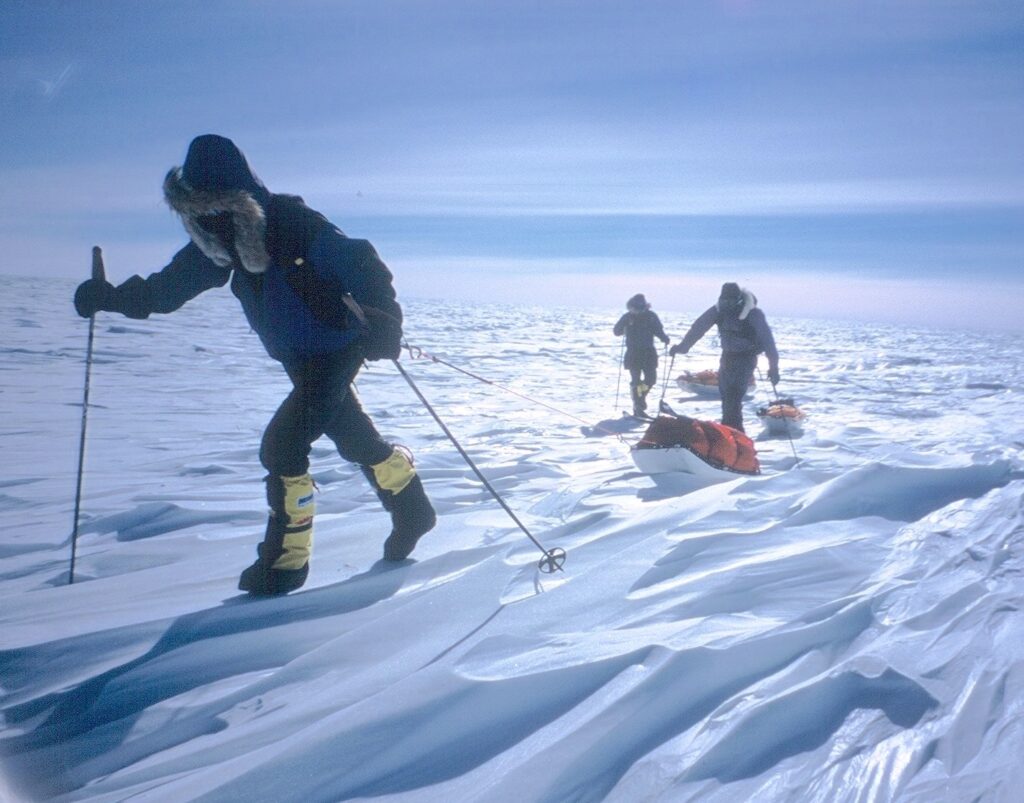
Tom on his South Pole expedition
Felice So presumably it’s wind dependent?
Tom It is wind dependent. We take three different sides of kites, depending on the strength of the wind. The wind is going to be blowing in a favourable direction. When we were skiing to the South Pole in 2002, actually the kite technology was quite basic so you couldn’t get that close to the wind. But kite technology has improved massively and it’s now possible to tack up into the wind. So it just gives you a much broader umbrella of wind that you can make onward progress in. And polar exploration has been transformed by the use of the kite. I mean, some of the conditions that have been going on over the last three or four years with these kites have been absolutely amazing.
You probably know about Leo Houlding‘s epic crossing of Antarctica with with kites a few years ago, and threw in an incredible climb of a mountain halfway through the trip. So it just opens up so many opportunities now that, of course, the likes of Shackleton never had the benefit of.
Peter How much does a laden sled weight?
Tom So our sleds going to the South Pole, they were about 80 kilos. Going across Greenland we actually each took two sleds because when you’re kiting, just for balance, you’ve got a bit more stability by effectively lashing two sleds together side-by-side than if you’re in a train. So Greenland was a bit lighter because it was a shorter trip. We were carrying only a couple of weeks’ worth of food and put our kites in there. So our loads across Greenland were nearer the 65 kilos per person mark.
Peter So that’s a lot. Without the sled, without the other kite, you’re pulling 85 kilos across uneven terrain. That’s exhausting.
Tom It is exhausting. It’s sort of strangely satisfying. You get into a trance, you get into a rhythm. I mean, thank God for iPods and being able to listen to music on the way – that does make a big difference. Of course, when we did our North Pole expedition back in 2005, where we were travelling with dogs, the loads were huge. The sleds weighed 300 kilos each. You’ve got eight dogs pulling each sled but the terrain is so undulating and way more extreme than anything we experienced in Antarctica and Greenland, because it’s practically a shifting ocean, a frozen ocean.

‘It’s the hardest part of going to the North Pole, obviously, it’s a frozen ocean.’
So you could have ridges that as high as 50 feet in height. And whilst the dogs are effectively doing the pulling on the flat stretches, the pan as it’s called may only last 300 yards at the longest, and then you’ve just got this extraordinary obstacle course that you’ve then got to cross and it’s all hands on deck and lifting the sled up and over the top of the ridge. And obviously the dogs are helping too, but the North Pole was without doubt the most physically demanding of the three Polar expeditions that we did.
Felice So did you have any setbacks? Did anything go wrong?
Tom Lots of things went wrong. God, I mean, the hardest part of going to the North Pole, obviously, it’s a frozen ocean. But as we know, the planet is warming and thickness of the ice cap of the Arctic Ocean is reducing year on year. We were actually recreating the first expedition to the North Pole on our trip – it was done by an American called Robert Peary in 1909. And the thickness of the ice in his day was about 12 foot. The average thickness when we were up there was less than six foot. But sometimes the ice might only be two or three inches thick.
And it’s a really fine balance deciding whether the ice is thick enough to cross or not. And there were several times when we got it wrong and dogs, sleds, people ended up in the water. And the water temperature of the Arctic Ocean is a steady minus 1.8 degrees Celsius, which is the temperature that sea water freezes air temperature –40. And you get out of that water and it’s a battle for survival. And actually, the thing that you do to warm up again isn’t to put the tent up and get the stove going, it’s to use that adrenaline that is sweeping through you. As soon as your little toe touches that freezing cold water you’ve just got to harness it, slip back into your skis and ski off to the horizon as fast as you possibly can, get your arms and legs moving again, because actually that heat, that body heat that you can generate, is a far more effective way of raising your core body temperature than being huddled over a stove in a tent. So it’s a real case of mind over matter. We all made it, humans and dogs alike.
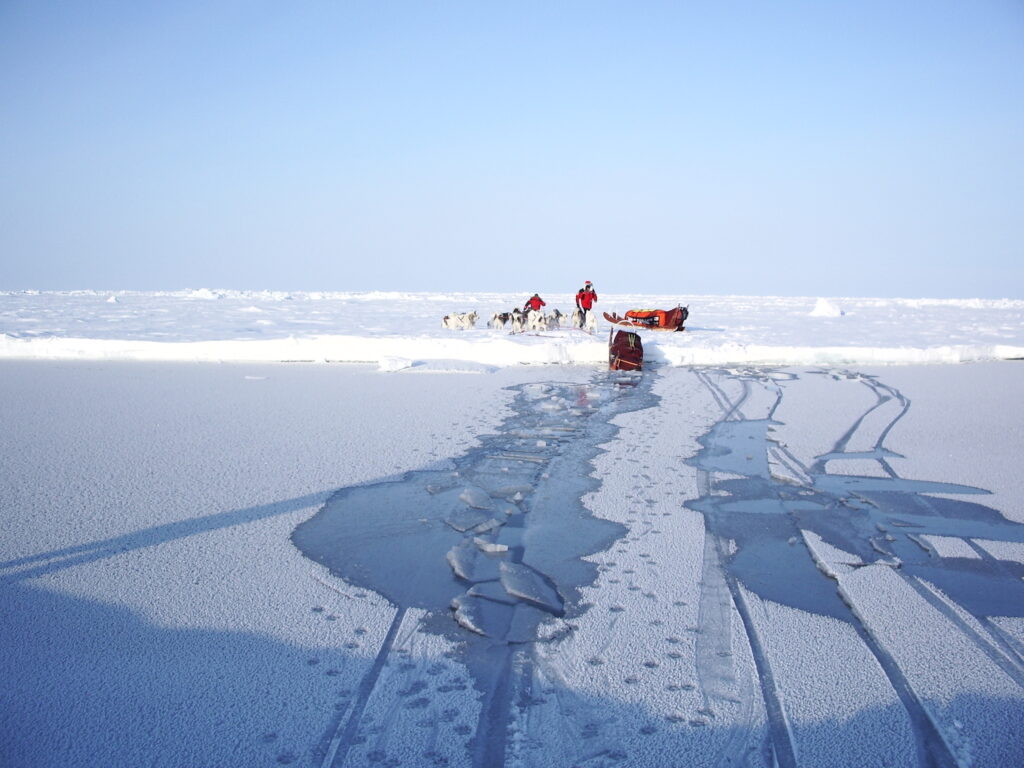
Tom’s North Pole dog-sledging expedition
Peter It sounds an extraordinarily unpleasant experience.
Tom Yes, it was pretty unpleasant. So, you know, a lot of people do ask me: ‘Why do this?’ But again, you’ve got to just think of the big picture, this extraordinary adventure. You know, like when we crossed Antarctica we had the whole continent pretty much to ourselves; this place that’s twice the size of Australia. You’re seeing views that hardly anyone had seen before and that you’re following in the footsteps of your childhood heroes. And it’s yes, it’s difficult and the blisters are just excruciating and every step hurts, and you might be eating the same disgusting freeze-dried meals every evening. But think of the positives and put those negatives to one side. It’d be so easy to throw in the towel, but we all kind of got behind one another.
There were days when one of us was up, the other ways down, and vice versa. And to get to the end and achieve our goals all together gave us all the most incredible sense of achievement. And I guess it makes us realise that whatever goals we set ourselves in our lives, nothing’s impossible if we put our minds to it and work hard and work together as a team.
Peter And indeed, I think you have two Guinness World Records?
Tom Yes. So incredibly, our North Pole record still stands 15 years on.
Peter So what was the record?
Tom So the record was …well Peary did it and back in 1909 it took him 37 days and two hours to reach the North Pole, having started from the north shore of Canada. And then nearly a century of travel, no one had come close to Peary’s time, which made a lot of people doubt whether or not Peary had made it to the Pole. And what our expedition was trying to do was to basically recreate his expedition. We built exact replicas of Peary’s sled, we used the same breed of dog with the goal of seeing how long it would take us to reach the pole.
And the closer we could get to Peary’s time, the stronger our argument would be to basically prove that this guy was the guy who discovered the North Pole, the first guy ever to get there. And against all the odds, we managed to do it. We beat his time by some four and a half hours. So that’s 36 days, 22 hours was our time and it hasn’t been beaten since. I don’t think it will. I’d love it to be broken because what that would mean is that there’s still sufficient ice in the Arctic Ocean to ski across, but it is melting so quickly now that I fear, even in the depths of the Arctic winter, I think there’s just too much open water now to make the route viable. Our crossing of Greenland, we did that. Obviously, the record was 17 days and we you know, we had some some pretty fierce winds and we managed to cross it in nine and a bit days. And yes, that record still out there to be to be broken. I’m sure it will do before too long.
Felice Going back to mountaineering, you’ve gone up, but you’ve also skied down some amazing mountains too?
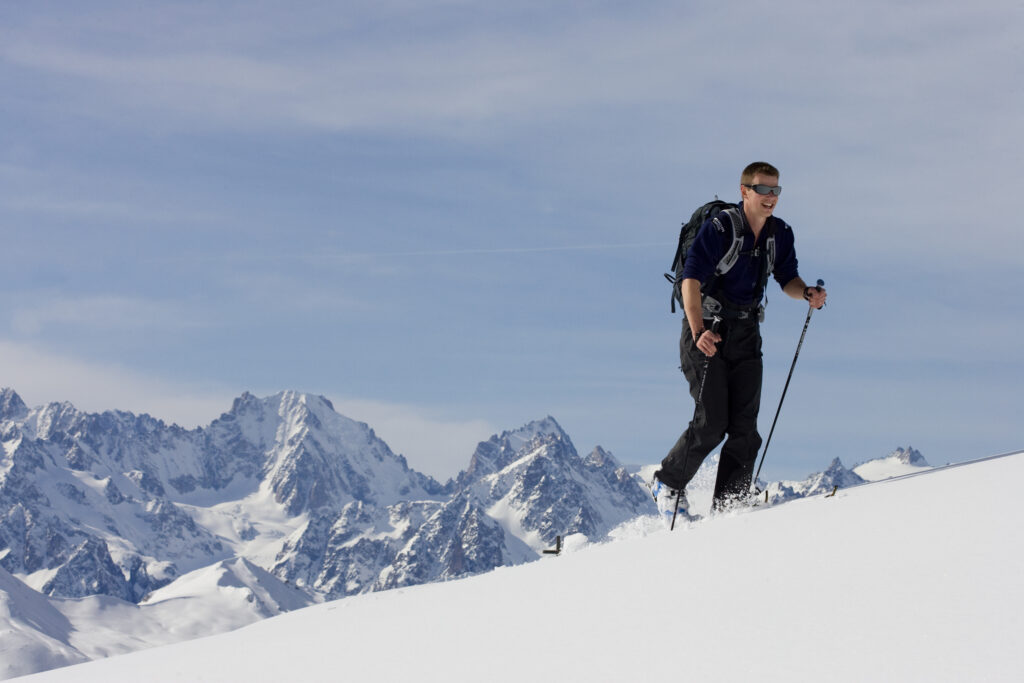
Tom ski-touring in Switzerland
Tom One of the great joys in life for me is ski-touring. I absolutely love putting skins on the bottom of a pair of skis and just going off away from the piste, away from the lift, whether that’s in the Alps, whether that’s up a volcano in Chile, whether that’s in the New Zealand Southern Alps. It’s being able to get away from it all that is a real thrill.
Back in 2006, I took my skis to the Himalayas because at the time no Brit had skied down an 8000-meter peak. So I teamed up with a friend of mine, Kenton Cool, who one of his country’s greatest mountaineers, having climbed Everest multiple times now. And he too was a keen skier. I was based in Verbier. He was based just over the border in Chamonix. And we set off to the to the Himalayas together with the intent of skiing down a mountain called Cho-Oyu, which is 8200 metres, very close to Everest, sort of on the Tibetan-Nepalese border, the sixth-highest mountain in the world.
And the idea was to make the first British descent of an 8000-metre peak. Unfortunately for me, about 6500 metres up, as a result of the altitude, I actually got a retinal haemorrhage in both my eyes and I completely lost my eyesight, thankfully, temporarily – 99 percent of it eventually came back, but at the time it was pretty frightening because I could not really see, and the option of carrying on up and skiing off this 8000-metre mountain, two months before my wedding day, I think was probably was not the most sensible thing to do.
Regrettably, I had to turn around and head straight to Moorfields Eye Hospital in London. Kenton amazingly carried on up to the summit and skied down very gingerly, but he did it and became the first Brit to ski down 8000-metre pan. So he subsequently’s been back and skied down more. So, yes, that was that was an incredible adventure. Sadly, it wasn’t meant to be, but you can’t win them all in this game, sadly.

At the summit of Couloir de la Rosablanche on the Patrouille des Glaciers
Peter And you took part in a what was the largest ski mountaineering race in the world?
Tom Yes, the Patrouille des Glaciers has been going since the Second World War. The Swiss in World War Two would dispatch patrols along the border, the southern border with Italy, to make sure that no one was coming over the border who shouldn’t be. And after the end of the war, as part of the Swiss National Service, the Patrouille des Glaciers – the patrol of the glaciers – has continued. So, to this day, patrols of three skiers will ski from Zermatt to Verbier with the idea. And it’s become a race and it’s huge. Thousands of skiers do this; the race is held every two years.
And back in 2006, myself and two old expedition mates became the first British team to complete the course. And it’s absolutely brutal; it’s 100 kilometres in length, over 4000 metres of ascent, 4000 metres of descent. You set off from the main square in Zermatt at ten o’clock at night, run down the main high street, the locals are outside the chalets ringing the cowbells, and then you disappear off up into the forest, up on the glacier, right past the Matterhorn. You can sort of see the silhouette of it against he the starry night over Tete Blanche, down to Arolla, and then various mountain poles and descents later, and eventually arriving in Verbier the following morning. Utterly horrendous 15 hours of my life, but we did it. And it’s all organised by the Swiss Army. It was a real privilege to take part in this legendary race.
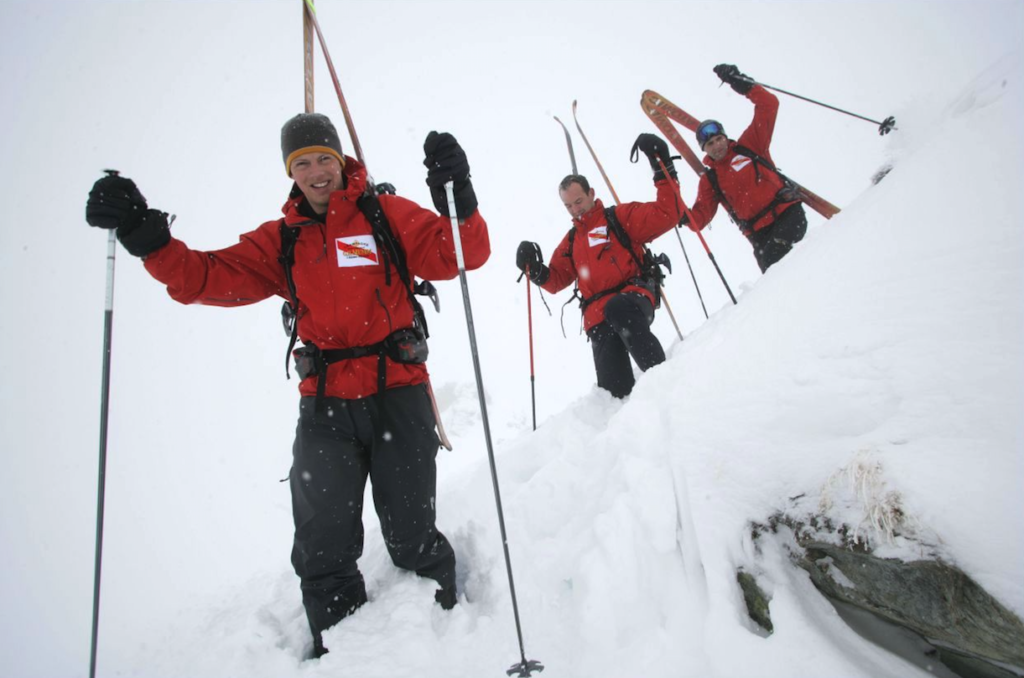
Tom competing in the Patrouille des Glaciers
Peter Retired, dare I say it, from expeditions, is that how you see it?
Tom Never retired, Peter. There’s plenty more adventures in the daydream.
Felice Which brings us to Verbier, how did you choose Verbier as the place to start a business or to run a business?
Tom So back in ‘99, after my pretty short-lived career in the City, I just wanted to get away from it all and I’d always dreamed of doing a ski season. And so a friend had done a winter in Verbier and told me that there was a job going as a driver for a company called Ski Verbier, and so I applied, got the job and never looked back. Verbier had it all really, it had these big, big mountains surrounding it, incredible views, and the setting of Verbier on this gorgeous south-facing plateau surrounded by these giant peaks. You could see across to the Mont Blanc Massif on one side and then as you head up the mountain, you could see across the Zermatt peaks and the Matterhorn and the Dome Blanche on the other. And the skiing, both on and off piste, just had so much.
And it had this extraordinary kind of frontier town feel to it. And these wide-eyed extreme skiers from the States or New Zealand or Finland or Sweden would descend on Verbier every winter and put in new routes and pioneer new lines and really push the boundaries of skiing, ski mountaineering…and I just fell in love with the place.
Peter And Ski Verbier Exclusive, how did that come about?
Tom I spent quite a lot of time after my first winter in Verbier, I then worked at Ski Verbier, the head office back in the UK for a couple of years and before leaving to head off to the South Pole. And on return from the South Pole, I was offered a book deal and I needed somewhere to write the book. So I thought, where better place to go than to Verbier. Problem was, there were quite a lot of distractions in Verbier, so not a lot of book writing got done, but a lot of skiing and climbing and fun did go on.
I was then more disciplined with my second book, which is about our North Pole expedition, so I ended up doing a few winters there and it was just the perfect training ground for the expedition, for book writing. So in 2009, we had some very exciting news, Mary and I, that she was pregnant with twins. And I realised at this point that I needed a more responsible way of putting food on the table than climbing up and down mountains and pulling sledges across ice caps.
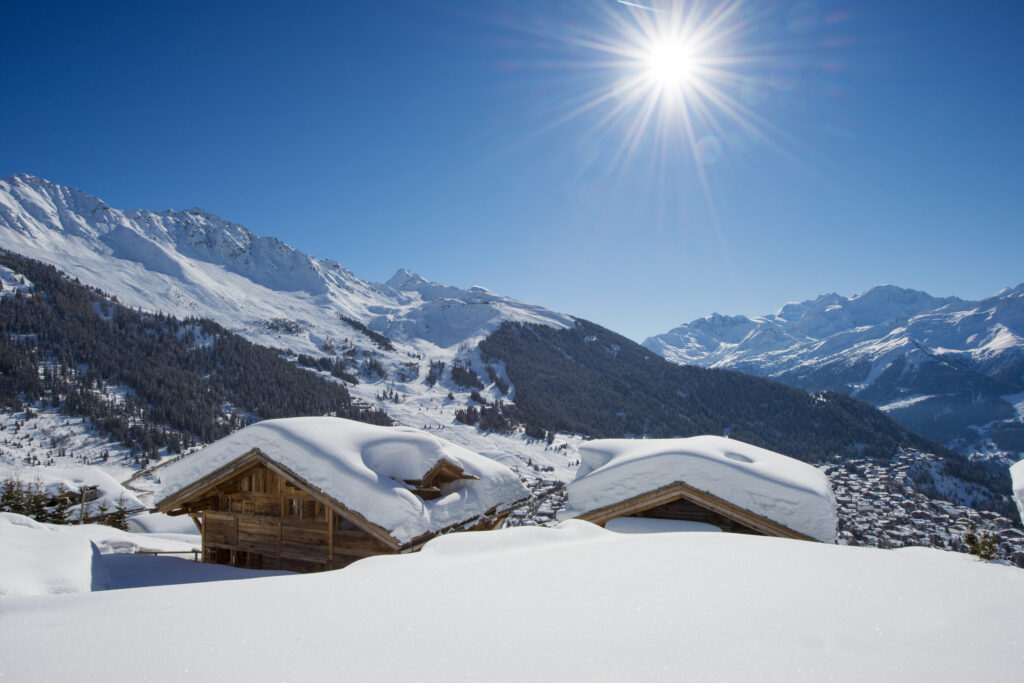
One of Ski Verbier Exclusive’s chalets, Nyumba
And so I figured that this was the time now to maybe have my own business in the Alps. So Verbier Exclusive began with just one chalet, very modest self-catered property. And over the years the business grew. And we now find ourselves 11 years later, with 16 fabulous chalets and an amazing team. And some of our chalets have been with us from the very early days, as have our team. And it’s such a privilege to be able to welcome the same guests to Verbier year on year who are as passionate about this extraordinary place as we are.
Felice How can people find out about Ski Verbier Exclusive? Can you tell us what the website is?
Tom So we are at Ski Verbier Exclusive.com. And we’ve done a huge amount of work on the website over the last few months and we’ve put some new video content up on the site just to give people a real idea of what a day in the life of a Ski Verbier Exclusive holiday is all about, because it’s quite hard to really convey just with images and text what our holidays are all about.
And we’re really proud of the videos that we’ve produced, and hope it gives a real flavour of our passion, and how much we care about our guests and giving them an incredible holiday in the mountains. We are remaining positive and optimistic that, as far as the lifts are concerned, yes there’ll be some social distancing in queues and there will be facemasks to be worn, but we will be able to go skiing this winter.
Peter Tom Avery, thank you for appearing on our travel podcast. You could find out about his Swiss chalet holidays by visiting Ski Verbier Exclusive and also about Tom’s life as an explorer at Tom Avery.net. Tom, we wish you the very best of luck, both with your chalet company and your future adventures, wherever in the world they may be.
Tom Thank you very much.
Felice That’s all for now. If you’ve enjoyed the show, please share this episode with at least one other person! Do also subscribe on Spotify, i-Tunes or any of the many podcast providers – where you can give us a rating. You can also find us on Twitter, Facebook and Instagram. Stay safe and we’ll see you next week.
© ActionPacked Travel

- Join over a hundred thousand podcasters already using Buzzsprout to get their message out to the world.
- Following the link lets Buzzsprout know we sent you, gets you a $20 Amazon gift card if you sign up for a paid plan, and helps support our show.
Also see our episode on Verbier resident, Warren Smith.

